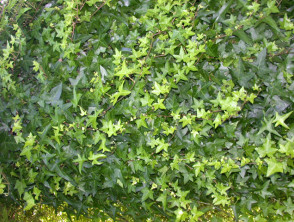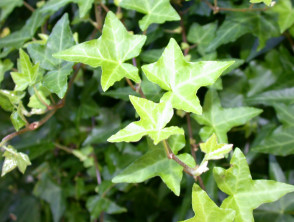| Common name: | English Ivy |
| Botanical name: | Hedera helix |
| Family: | Araliaceae (ginseng family). |
| Origin: | Originally from temperate Europe where it was found in woods and hedgerows. Commonly found growing on trees, walls and sides of houses. |
| Description: | A woody evergreen plant which often grows as a creeper. Five lobed green leaves although a number of variegated cultivars exist. Yellowish green flowers may be seen in autumn. Black globular berries. |
| Uses: | Extracts from english ivy have been used as tonics, expectorants and as poutices for bruises. |
| Allergens: | Falcarinol (a diacetylene; heptadeca-1,9-diene-4,6-diyne-3-ol) and didehydrofalcarinol. |
| Allergy: | Both irritant and allergic contact dermatitis has been reported from contact with English ivy, usually after pulling off creepers from walls, trees, etc. However, it has been reported in children following contact by climbing in trees covered with ivy. |
| Cross reactions: | Cross reactions with Queensland umbrella tree: Brassaia (Schefflera) actinophyllaa common house plant. May also cross react with members of the carrot and celery family (Umbilliferae) which may contain falcarinol. |
| Other information: | Berries are poisonous if eaten. English ivy should not be confused with ground ivy or poison ivy (Toxicodendron spp.) which are different species. |
| Patch test: | Leaf as is, falcarinol 0.1%. |

